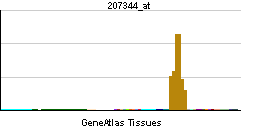AKAP3
| A kinase (PRKA) anchor protein 3 | |||||||||||
|---|---|---|---|---|---|---|---|---|---|---|---|
| Identifiers | |||||||||||
| Symbols | AKAP3 ; AKAP110; FSP95; PRKA3; SOB1 | ||||||||||
| External IDs | Template:OMIM5 Template:MGI HomoloGene: 4688 | ||||||||||
| |||||||||||
| RNA expression pattern | |||||||||||
 | |||||||||||
| More reference expression data | |||||||||||
| Orthologs | |||||||||||
| Template:GNF Ortholog box | |||||||||||
| Species | Human | Mouse | |||||||||
| Entrez | n/a | n/a | |||||||||
| Ensembl | n/a | n/a | |||||||||
| UniProt | n/a | n/a | |||||||||
| RefSeq (mRNA) | n/a | n/a | |||||||||
| RefSeq (protein) | n/a | n/a | |||||||||
| Location (UCSC) | n/a | n/a | |||||||||
| PubMed search | n/a | n/a | |||||||||
A kinase (PRKA) anchor protein 3, also known as AKAP3, is a human gene.[1]
The A-kinase anchor proteins (AKAPs) are a group of structurally diverse proteins, which have the common function of binding to the regulatory subunit of protein kinase A (PKA) and confining the holoenzyme to discrete locations within the cell. This gene encodes a member of the AKAP family, and is expressed in testis only. The encoded protein contains an RII-binding domain, and is predicted to participate in protein-protein interactions with the R-subunit of the PKA. This protein is localized to the ribs of the fibrous sheath in the principal piece of the sperm tail. It may function as a regulator of both motility- and head-associated functions such as capacitation and the acrosome reaction.[1]
References
Further reading
- Lester LB, Scott JD (1997). "Anchoring and scaffold proteins for kinases and phosphatases". Recent Prog. Horm. Res. 52: 409–29, discussion 429-30. PMID 9238861.
- Michel JJ, Scott JD (2002). "AKAP mediated signal transduction". Annu. Rev. Pharmacol. Toxicol. 42: 235–57. doi:10.1146/annurev.pharmtox.42.083101.135801. PMID 11807172.
- Vijayaraghavan S, Liberty GA, Mohan J; et al. (1999). "Isolation and molecular characterization of AKAP110, a novel, sperm-specific protein kinase A-anchoring protein". Mol. Endocrinol. 13 (5): 705–17. PMID 10319321.
- Lefevre A, Duquenne C, Rousseau-Merck MF; et al. (1999). "Cloning and characterization of SOB1, a new testis-specific cDNA encoding a human sperm protein probably involved in oocyte recognition". Biochem. Biophys. Res. Commun. 259 (1): 60–6. doi:10.1006/bbrc.1999.0728. PMID 10334916.
- Mandal A, Naaby-Hansen S, Wolkowicz MJ; et al. (1999). "FSP95, a testis-specific 95-kilodalton fibrous sheath antigen that undergoes tyrosine phosphorylation in capacitated human spermatozoa". Biol. Reprod. 61 (5): 1184–97. PMID 10529264.
- Carr DW, Fujita A, Stentz CL; et al. (2001). "Identification of sperm-specific proteins that interact with A-kinase anchoring proteins in a manner similar to the type II regulatory subunit of PKA". J. Biol. Chem. 276 (20): 17332–8. doi:10.1074/jbc.M011252200. PMID 11278869.
- Niu J, Vaiskunaite R, Suzuki N; et al. (2002). "Interaction of heterotrimeric G13 protein with an A-kinase-anchoring protein 110 (AKAP110) mediates cAMP-independent PKA activation". Curr. Biol. 11 (21): 1686–90. PMID 11696326.
- Strausberg RL, Feingold EA, Grouse LH; et al. (2003). "Generation and initial analysis of more than 15,000 full-length human and mouse cDNA sequences". Proc. Natl. Acad. Sci. U.S.A. 99 (26): 16899–903. doi:10.1073/pnas.242603899. PMID 12477932.
- Ficarro S, Chertihin O, Westbrook VA; et al. (2003). "Phosphoproteome analysis of capacitated human sperm. Evidence of tyrosine phosphorylation of a kinase-anchoring protein 3 and valosin-containing protein/p97 during capacitation". J. Biol. Chem. 278 (13): 11579–89. doi:10.1074/jbc.M202325200. PMID 12509440.
- Brown PR, Miki K, Harper DB, Eddy EM (2004). "A-kinase anchoring protein 4 binding proteins in the fibrous sheath of the sperm flagellum". Biol. Reprod. 68 (6): 2241–8. doi:10.1095/biolreprod.102.013466. PMID 12606363.
- Hasegawa K, Ono T, Matsushita H; et al. (2003). "A-kinase anchoring protein 3 messenger RNA expression in ovarian cancer and its implication on prognosis". Int. J. Cancer. 108 (1): 86–90. doi:10.1002/ijc.11565. PMID 14618620.
- Lea IA, Widgren EE, O'Rand MG (2004). "Association of sperm protein 17 with A-kinase anchoring protein 3 in flagella". Reprod. Biol. Endocrinol. 2: 57. doi:10.1186/1477-7827-2-57. PMID 15257753.
- Sharma S, Qian F, Keitz B; et al. (2005). "A-kinase anchoring protein 3 messenger RNA expression correlates with poor prognosis in epithelial ovarian cancer". Gynecol. Oncol. 99 (1): 183–8. doi:10.1016/j.ygyno.2005.06.006. PMID 16005946.
- Lefièvre L, Chen Y, Conner SJ; et al. (2007). "Human spermatozoa contain multiple targets for protein S-nitrosylation: an alternative mechanism of the modulation of sperm function by nitric oxide?". Proteomics. 7 (17): 3066–84. doi:10.1002/pmic.200700254. PMID 17683036.
| This protein-related article is a stub. You can help Wikipedia by expanding it. |